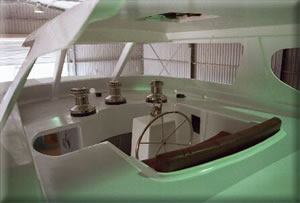 |
|
|||||||||||||||||||||||||||||||||
Construction and Materials
Traditionally in boatbuilding wood, steel and aluminum were used.
 These
materials are not suitable for performance boats, because the strength
to weight ratio does not enable a yacht under 50 meters to be
built light enough to perform well. Add to that the downside of rotten
wood, rusted steel and cracked and corroded aluminum – and you’re
faced with high maintenance and reduced durability.
These
materials are not suitable for performance boats, because the strength
to weight ratio does not enable a yacht under 50 meters to be
built light enough to perform well. Add to that the downside of rotten
wood, rusted steel and cracked and corroded aluminum – and you’re
faced with high maintenance and reduced durability.
That’s why today most modern boats and all high performance yachts are built from different resins and fabrics – such as fiberglass, Kevlar, carbon fiber, polyester, vinylester and epoxy.
If you’re a builder or skipper and use any of these items for your yacht, you’ll no doubt find the following information interesting.
Fiberglass cloth has been around for several decades and is a popular material for building boat hulls. Made up of twisted strands of fiberglass woven at right angles to one another, of all the fabrics, fiberglass cloth is the easiest one to work with because it does not require special techniques to lay it up.
 Kevlar is one of the most interesting of the hi-tech fabrics. Dupont developed
Kevlar in the early 70’s for fibers in automobile tires.
It was later discovered that Kevlar, when woven into cloth and layered,
can be made into bulletproof vests. Kevlar is low stretch, very
strong,
and very lightweight, making it good for building sailboat
hulls. On
the downside it is expensive, at times hard to work with and difficult
to obtain.
Kevlar is one of the most interesting of the hi-tech fabrics. Dupont developed
Kevlar in the early 70’s for fibers in automobile tires.
It was later discovered that Kevlar, when woven into cloth and layered,
can be made into bulletproof vests. Kevlar is low stretch, very
strong,
and very lightweight, making it good for building sailboat
hulls. On
the downside it is expensive, at times hard to work with and difficult
to obtain.
Carbon fiber is another hi-tech fabric that is now being used in boat construction. It consists almost totally of molecules of carbon bound together with resins and woven into a cloth. The fiber has enormous strength and is very lightweight, but prone to fracture when hit. To overcome this, it is used in conjunction with Kevlar to allow better flexing. Where it really shines is in its use for keel fins, masts, and booms. Carbon fiber is costly, hard to get, and takes effort to lay-up.
Polyester resin is inexpensive but not very strong. It is the standard for laying up fiberglass cloth. Polyester resin has a high scent profile, not very well liked when used in the house, and messy to clean up. The upside is the low cost factor and ready availability.
Vinylester resin is stronger, more flexible, and only a little more expensive than polyester resin. Vinylester resin is used to lay up Kevlar cloth.
Epoxy resin is the strongest and most expensive of the resins, and used to lay up carbon fiber cloth. Epoxy resin does not give off a pungent odor as the other resins do.
Even though it is not used as a building resin, gel-coat is a coloured resin used on the outside of boat hulls before the cloth and building resin is applied. Its main purpose is to provide a nice outer finish to the hull, but its drawback is weight.
 |
 |